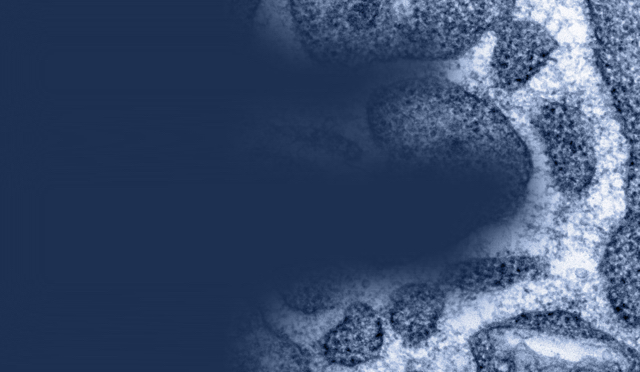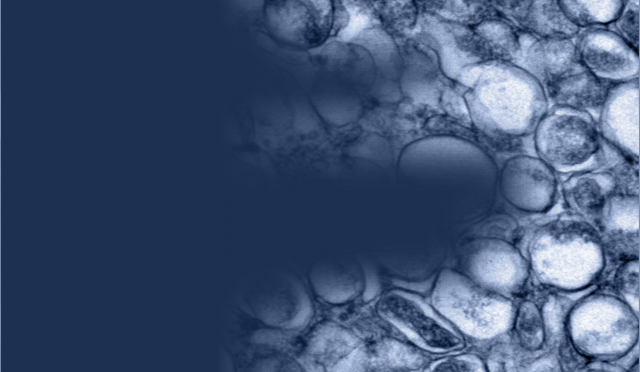Publications
-
(2019) Nature Microbiology. 4, 12, p. 2523-2537 Abstract
Enteroviruses (EVs) comprise a large genus of positive-sense, single-stranded RNA viruses whose members cause a number of important and widespread human diseases, including poliomyelitis, myocarditis, acute flaccid myelitis and the common cold. How EVs co-opt cellular functions to promote replication and spread is incompletely understood. Here, using genome-scale CRISPR screens, we identify the actin histidine methyltransferase SET domain containing 3 (SETD3) as critically important for viral infection by a broad panel of EVs, including rhinoviruses and non-polio EVs increasingly linked to severe neurological disease such as acute flaccid myelitis (EV-D68) and viral encephalitis (EV-A71). We show that cytosolic SETD3, independent of its methylation activity, is required for the RNA replication step in the viral life cycle. Using quantitative affinity purificationmass spectrometry, we show that SETD3 specifically interacts with the viral 2A protease of multiple enteroviral species, and we map the residues in 2A that mediate this interaction. 2A mutants that retain protease activity but are unable to interact with SETD3 are severely compromised in RNA replication. These data suggest a role of the viral 2A protein in RNA replication beyond facilitating proteolytic cleavage. Finally, we show that SETD3 is essential for in vivo replication and pathogenesis in multiple mouse models for EV infection, including CV-A10, EV-A71 and EV-D68. Our results reveal a crucial role of a host protein in viral pathogenesis, and suggest targeting SETD3 as a potential mechanism for controlling viral infections.
-
(2019) Cell (Cambridge). 178, 2, p. 275-289.e16 Abstract
Positive-stranded RNA viruses extensively remodel host cell architecture to enable viral replication. Here, we examined the poorly understood formation of specialized membrane compartments that are critical sites for the synthesis of the viral genome. We show that the replication compartments (RCs) of enteroviruses are created through novel membrane contact sites that recruit host lipid droplets (LDs) to the RCs. Viral proteins tether the RCs to the LDs and interact with the host lipolysis machinery to enable transfer of fatty acids from LDs, thereby providing lipids essential for RC biogenesis. Inhibiting the formation of the membrane contact sites between LDs and RCs or inhibition of the lipolysis pathway disrupts RC biogenesis and enterovirus replication. Our data illuminate mechanistic and functional aspects of organelle remodeling in viral infection and establish that pharmacological targeting of contact sites linking viral and host compartments is a potential strategy for antiviral development. The specialized compartments where enteroviruses replicate are created through membrane contact sites where viral proteins tether host lipid droplets to replication compartments enabling the transfer of fatty acids.
-
(2018) Cell (Cambridge). 175, 7, p. 1931-1945.e18 Abstract
Mosquito-borne flaviviruses, including dengue virus (DENV) and Zika virus (ZIKV), are a growing public health concern. Systems-level analysis of how flaviviruses hijack cellular processes through virus-host protein-protein interactions (PPIs) provides information about their replication and pathogenic mechanisms. We used affinity purification-mass spectrometry (AP-MS) to compare flavivirus-host interactions for two viruses (DENV and ZIKV) in two hosts (human and mosquito). Conserved virus-host PPIs revealed that the flavivirus NS5 protein suppresses interferon stimulated genes by inhibiting recruitment of the transcription complex PAF1C and that chemical modulation of SEC61 inhibits DENV and ZIKV replication in human and mosquito cells. Finally, we identified a ZIKV-specific interaction between NS4A and ANKLE2, a gene linked to hereditary microcephaly, and showed that ZIKV NS4A causes microcephaly in Drosophila in an ANKLE2-dependent manner. Thus, comparative flavivirus-host PPI mapping provides biological insights and, when coupled with in vivo models, can be used to unravel pathogenic mechanisms. Comparing protein-protein interactions across dengue and Zika viruses reveals both common mechanisms and functionally distinct pathways contributing to infection outcomes.
-
(2013) Traffic. 14, 10, p. 1065-1077 Abstract
Multiple mutations in different subunits of the tethering complex Conserved Oligomeric Golgi (COG) have been identified as a cause for Congenital Disorders of Glycosylation (CDG) in humans. Yet, the mechanisms by which COG mutations induce the pleiotropic CDG defects have not been fully defined. By detailed analysis of Cog8 deficiency in either HeLa cells or CDG-derived fibroblasts, we show that Cog8 is required for the assembly of both the COG complex and the Golgi Stx5-GS28-Ykt6-GS15 and Stx6-Stx16-Vti1a-VAMP4 SNARE complexes. The assembly of these SNARE complexes is also impaired in cells derived from a Cog7-deficient CDG patient. Likewise, the integrity of the COG complex is also impaired in Cog1-, Cog4- and Cog6-depleted cells. Significantly, deficiency of Cog1, Cog4, Cog6 or Cog8 distinctly influences the production of COG subcomplexes and their Golgi targeting. These results shed light on the structural organization of the COG complex and its subcellular localization, and suggest that its integrity is required for both tethering of transport vesicles to the Golgi apparatus and the assembly of Golgi SNARE complexes. We propose that these two key functions are generally and mechanistically impaired in COG-associated CDG patients, thereby exerting severe pleiotropic defects.
-
(2013) EMBO Reports. 14, 10, p. 891-899 Abstract
Phosphatidic acid (PA) and phosphoinositides are metabolically interconverted lipid second messengers that have central roles in many growth factor (GF)-stimulated signalling pathways. Yet, little is known about the mechanisms that coordinate their production and downstream signalling. Here we show that the phosphatidylinositol (PI)-transfer protein Nir2 translocates from the Golgi complex to the plasma membrane in response to GF stimulation. This translocation is triggered by PA formation and is mediated by its C-terminal region that binds PA in vitro. We further show that depletion of Nir2 substantially reduces the PI(4,5)P2 levels at the plasma membrane and concomitantly GF-stimulated PI(3,4,5)P3 production. Finally, we show that Nir2 positively regulates the MAPK and PI3K/AKT pathways. We propose that Nir2 through its PA-binding capability and PI-transfer activity can couple PA to phosphoinositide signalling, and possibly coordinates their local lipid metabolism and downstream signalling.
-
(2013) Journal of Cell Science. 126, 6, p. 1506-1516 Abstract
Multisubunit tethering complexes (MTCs) positively regulate vesicular fusion by as yet unclear mechanism. In this study we provide evidence that the MTC COG enhances the assembly of fusogenic Golgi SNARE complexes and concomitantly prevents nonfusogenic tSNARE interactions. This capability is possibly mediated by multiple direct interactions of COG subunits and specific Golgi SNAREs and SM (Sec1/Munc18) proteins. By using a systematic co-immunoprecipitation analysis, we identified seven new interactions between the COG subunits and components of the Golgi fusion machinery in mammalian cells. Our studies suggest that these multivalent interactions are critical for the assembly of fusogenic SNARE complexes on the Golgi apparatus and consequently for facilitating endosome-to-trans-Golgi network (TGN) and intra-Golgi retrograde transport, and also for coordinating these transport routes.
-
(2011) Journal of Cell Biology. 194, 3, p. 459-472 Abstract
The conserved oligomeric Golgi (COG) complex has been implicated in the regulation of endosome to trans-Golgi network (TGN) retrograde trafficking in both yeast and mammals. However, the exact mechanisms by which it regulates this transport route remain largely unknown. In this paper, we show that COG interacts directly with the target membrane SNARE (t-SNARE) Syntaxin 6 via the Cog6 subunit. In Cog6-depleted cells, the steady-state level of Syntaxin 6 was markedly reduced, and concomitantly, endosome-to-TGN retrograde traffic was significantly attenuated. Cog6 knockdown also affected the steady-state levels and/or subcellular distributions of Syntaxin 16, Vti1a, and VAMP4 and impaired the assembly of the Syntaxin 6-Syntaxin16-Vti1a-VAMP4 SNARE complex. Remarkably, overexpression of VAMP4, but not of Syntaxin 6, bypassed the requirement for COG and restored endosome-to-TGN trafficking in Cog6-depleted cells. These results suggest that COG directly interacts with specific t-SNAREs and positively regulates SNARE complex assembly, thereby affecting their associated trafficking steps.
-
(2009) EMBO Journal. 28, 14, p. 2006-2017 Abstract
The crucial roles of Sec1/Munc18 (SM)-like proteins in membrane fusion have been evidenced in genetic and biochemical studies. SM proteins interact directly with SNAREs and contribute to SNARE pairing by a yet unclear mechanism. Here, we show that the SM protein, Sly1, interacts directly with the conserved oligomeric Golgi (COG) tethering complex. The Sly1-COG interaction is mediated by the Cog4 subunit, which also interacts with Syntaxin 5 through a different binding site. We provide evidence that disruption of Cog4-Sly1 interaction impairs pairing of SNAREs involved in intra-Golgi transport thereby markedly attenuating Golgi-to-ER retrograde transport. These results highlight the mechanism by which SM proteins link tethering to SNAREpin assembly.
-
(2005) Journal of Biomolecular Structure and Dynamics. 23, 3, p. 257-265 Abstract
Translin is a human single-stranded DNA and RNA binding protein that has been highly conserved in eukaryotic evolution. It consists of eight subunits having a highly helical secondary structure that assemble into a ring. The DNA and the RNA are bound inside the ring. Recently, some of us demonstrated that the human translin specifically binds the single-stranded microsatellite repeats, d(GT)n, the human telomeric repeats, d(TTAGGG)n, and the Tetrahymena telomeric repeats, d(GGGGTT)n. These data suggested that translin might be involved in recombination at d(GT)n·d(AC)n microsatellites and in telomere metabolism [E. Jacob, L. Pucshansky, E. Zeruya, N. Baran, H. Manor. J. Mol. Biol. 344, 939950 (2004), S. Cohen, E. Jacob, H. Manor. Biochim. Biophys. Acta. 1679, 129140 (2004)]. Other data indicated that translin might stimulate binding of telomerase to single-stranded telomeric overhangs by unwinding secondary structures formed by the telomeric repeats [S. Cohen, E. Jacob, H. Manor. Biochim. Biophys. Acta. 1679, 129140 (2004)]. Here we present a circular dichroism (CD) analysis of complexes formed between the human translin and the microsatellite and telomeric oligodeoxynucleotides d(GT) and d(TTAGGG)5. We report that conformational changes occur in both the translin and the oligodeoxynucleotides upon formation of the complexes. In translin octamers bound to the oligodeoxynucleotide d(GT)12, the fraction of a-helices decreases from ∼67% to ∼50%, while the fraction of turns and of the unordered structure increases from ∼11% to ∼17% and from ∼19% to ∼24%, respectively. In the bound oligodeoxynucleotide d(GT), we observed CD shifts which are consistent with a decrease of base stacking and a putative anti-syn switch of some guanines. The oligodeoxynucleotide d(TTAGGG)5 formed intramolecular quadruplexes under the conditions of our assays and translin was found to unfold the quadruplexes into structures consisting of a single hairpin and three unwound single-stranded d(TTAGGG) repeats. We suggest that such unfolding could account for the stimulation of telomerase activity by translin mentioned above.
-
(2005) Nucleic Acids Research. 33, 13, p. 4128-4139 Abstract
Translin is a human octameric protein that specifically binds the single-stranded microsatellite repeats d(GT)n and the corresponding transcripts (GU)n. It also binds, with lesser affinities, other single-stranded G-rich DNA and RNA sequences. TRAX is a human protein that bears a homology to Translin and interacts with it. Translin and TRAX have been proposed to be involved in DNA recombination, chromosomal translocation and mRNA transport and translation. Both proteins are highly conserved in eukaryotes, including the fission yeast Schizosaccharomyces pombe, which is amenable to genetic analysis. Here, we report the first study of the S.pombe Translin and TRAX homologs. We have deleted the genes encoding Translin and TRAX in S.pombe and found that the proliferation of the mutant cells was slightly stimulated, suggesting that these genes are not essential for the fission yeast. We have also shown that the S.pombe Translin and TRAX interact. Biochemical analysis of the S.pombe Translin, which was cloned and expressed in Escherichia coli, revealed that it is octameric and that it selectively binds d(GT)n and d(GTT)n microsatellite repeats. However, unlike the human protein, it has much higher affinities for the homologous RNA sequences (GU)n and (GUU)n. These data suggest that the S.pombe Translin is primarily involved in functions related to RNA metabolism.








